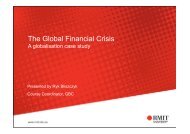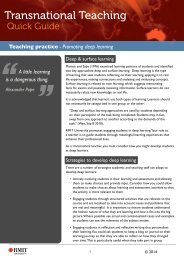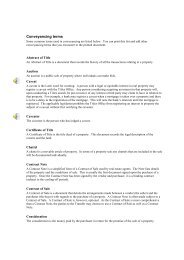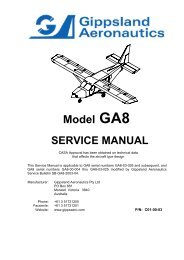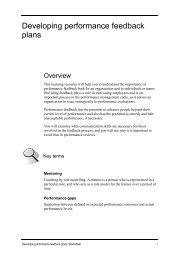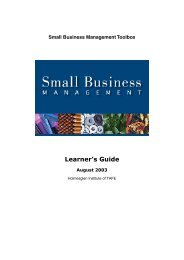Conduct exit interviews worksheet - Flexible Learning Toolboxes
Conduct exit interviews worksheet - Flexible Learning Toolboxes
Conduct exit interviews worksheet - Flexible Learning Toolboxes
Create successful ePaper yourself
Turn your PDF publications into a flip-book with our unique Google optimized e-Paper software.
• notification of possible problem areas within specific departments.Management and HR will then discuss how to best use this information forretention of good employees, recruitment of future staff, cost control andevaluation of company processes.Items on your checklist should include the following:• An agenda for the <strong>exit</strong> interview• A list of all who should be present at the interview• A list of any company property that should be returned• The notice of termination (if applicable). Note: Be careful of whatyou put in writing. Some HR practitioners give the employee twocopies to take away, asking them to sign them and return one whenthey’ve had time to read it through properly (usually at the <strong>exit</strong>interview).• A departure package (similar to the orientation package given tonew employees). That package may include advice onsuperannuation, tax forms for the employee and a guide as to theoptions faced.• Contact details for your outplacement agency (where applicable).• Someone who takes extensive notes of the <strong>exit</strong> interview throughoutInterview techniquesThe following are interviewing strategies that are designed to help establishthe goals discussed earlier, while decreasing the employee’s resistance todisclosing information.Table 2: Interview techniques and tips (2 cols)TechniqueAsk open-endedquestions.Ask—don’t tell.Use reflectivelistening.TipAvoid using questions that will elicit a short answer (e.g.,‘Tell me more about these difficulties’ as opposed to‘Have you had difficulties with this?’)Spend far more time listening than you do talking. Allowthe person to do most of the talking. (Aim for a 70/30listening to talking ratio).Look for the underlying meaning of what is being saidand reflect this back to the person. Focus on how theperson is feeling.10 <strong>Conduct</strong> <strong>exit</strong> <strong>interviews</strong>: Worksheet2002_329_026 July 2003






